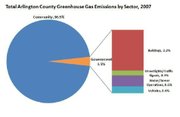Arlington County has a new goal to slash carbon emissions. But the first-ever community energy plan unanimously adopted last month imposes no mandates or penalties if residents and business fail to clean up their act. And it doesn’t set any money aside for strategic investments. It doesn’t have a cost estimate. That makes the plan as more an aspiration than a command, which may prove challenging considering the sweeping change called for in reducing the county’s carbon emissions from 13.4 million metric tons to 3 million metric tons over the next 40 years.
"We think the plan will stand on its own," said Richard Dooley, community energy plan project manager. "Even without a lot of sticks in terms of the county mandating behavior."
That may be a tall order. Considering 75 percent of the emissions in Arlington come from the building sector, drastic changes need to take place in the next half century. To slash 10.4 metric tons of carton dioxide emission out of the atmosphere in the next half-century, old buildings will need to be retrofitted and new buildings need to be constructed differently. They also need to be used differently.
"What drives energy consumption is who is in the building and how they are using it," said Brian Turmail, spokesman for the Arlington-based Association of General Contractors of America. "What the code doesn’t anticipate is what kind of equipment will be needed in the future — will every desk have five computers or will everyone be walking around with a tablet?"
THE FUTURE IS SO BRIGHT in Arlington, it’s gotta wear shades. That was the conclusion of a task force assembled to consider the future of the county’s energy needs. The goal was to separate energy planning from other land-use issues, crafting a document that was specifically focused on reducing consumption. After months of meetings, the task force presented recommendations earlier this year. Now the Arlington County Board has approved the aspiration goal of reducing emissions without mandating changes or imposing penalties.
"This proposed energy plan is an important milestone for Arlington," said County Board Chairman Chris Zimmerman in a written statement. "Arlington can develop medium and long-range plans that will reduce energy use and costs, cut greenhouse gas emissions, and help ensure our community’s sustainability."
County officials say the goal of reducing carbon emissions in such a dramatic fashion will take regional coordination. The plan adopted last month assumes that a regional energy plan will be created that will help Arlington achieve an annual reduction of about 2.2 metric tons each year. It also assumes that the business community will become willing partners, voluntarily opting to reduce emissions without the threat of regulatory punishment.
"The chamber generally supports energy efficiencies but knows that our members must weigh the investment and return," said Rich Doud, president of the Arlington Chamber of Commerce. "This is simply a good business practice."
THE COUNTY’S FIRST climate action program, known as the Arlington Initiative to Reduce Emissions, set a goal of reducing the government’s greenhouse gas emissions by 10 percent from 2000 to 2012. Today the government has essentially the same emissions as it did in the 2000, even though the county now has thousands of new streetlights, dozens of new traffic signals and a 16 percent increase in building square footage. According to the Arlington County Department of Environmental Services, the county is responsible for only 4 percent of the emissions in Arlington.
"The county’s operations are just a drop in the bucket compared to the community," said Dooley.
That puts the target squarely on the business community to make the kind of changes necessary to reduce emissions. Unlike the Arlington Initiative to Reduce Emissions — known as AIRE — the goal of the new energy plan will be much more difficult to reach than a 10 percent reduction. And while the aim of AIRE was to reduce emissions from operations the government controlled, the new energy plan seeks to accomplish change from residents and businesses outside the government’s control.
"The chamber was allowed a lot of participation in the process and input to the report," said Doud. "The plan will emerge after completion of the next phase, an implementation report on how these goals might be realized."
ONE WAY THE PLAN will be implemented includes the installation of a district energy system. The staff report on the plan calls this "one of the most significant changes in Arlington’s energy future." The district energy system county officials hope to use would link multiple buildings in high-density areas with underground pipes carrying hot and cold water for heating and cooling. And instead of taking power from plants hundreds of miles away, the district energy system would use local systems.
"This scenario would create a district energy system tailored to the specific needs of each neighborhood and retain flexibility to adapt to changing technologies and markets long into the future," the staff report on the plan explained.
For homes that are in low-density areas, which represent about one-quarter of Arlington’s energy use, the plan recommends homeowners use solar-thermal water, space-heating systems, solar daylighting and ground-source heat pumps. To reduce peak electrical demands on hot summer days, the plan calls for the use of rooftop photovoltaic systems to convert sunlight into electricity. The goal outlined in the plan is for the county to have 160 megawatts of solar photovoltaic electricity generated in Arlington by 2025, although it’s not year clear how that would happen.
"We don’t have all the answers now," acknowledged Dooley.
